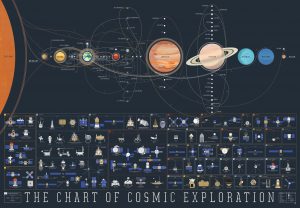Click here for a zoomable image (Courtesy of Big Think)
A Chart of Cosmic Exploration, on its surface, may seem like a harmless, information-delivering apparatus intended for a casual audience. However, at a time when science is being politicized, this chart comes as a way for that casual audience to get in touch with a side of humanity that has always pushed us forward: our need to explore.
The first choice of the author is blatant, yet is easily naturalized in the map. The choice to make the solar system appear linear, with the Sun barely making it on the page on the far-left side, and Jupiter catching the eye as the apparent center of the system, is reflective of a long struggle between traditional thinkers and scientists. There was a time when astronomers were jailed for suggesting Earth was not the center of our universe because their remarks threatened religious institutions and the like. Even though all of the spacecraft originate from Earth, Jupiter is undoubtedly the center of the map. Given that our solar system exists in a vacuum with no sense of direction other than what we assign as relative to the Sun, it is clear there must have been distinct intention by the author to create the two-dimensional map with our Sun to the left, Jupiter in the middle and Planet 9 all the way on the right.
The second most important choice by the author was not including any sign of nationality. Looking closely at the image of Earth, North and South America, as well as portions of Europe and Africa, are the only continents in view. However, other than that inclusion, which can be attributed to the fact this map was American made, none of the spacecraft, all of which originated from countless countries (The European Space Agency is responsible for a number of the launches, and through corporation partnerships/direct memberships is associated 31 different countries) have no country of origin on the map. The Chart breaks each craft down by its destination, purpose (Fly-by, Orbiter, Lander, Atmospheric Probe, or Rover) and name. In a field of research born into and defined by the Cold War space race, it is remarkable that in today’s day and age, perhaps the only comprehensive chart of man’s endeavors into our universe is not defined by nationalities. This speaks in volume to the idea that exploration is an inherent trait in all humans, not just Americans.
This map, though simple at first look, compels its readers to find their need to explore. As science is generally associated with being math-centric and complicated, an intentionally neat, aesthetically pleasing map allows casual readers to interact with what they may only find elsewhere in scholarly journals or 100-page Wikipedia articles.
References
Berman, Robby. “A Massive Poster of Earth’s Spacecraft and Missions, So Far.” Big Think. 04 Dec. 2016.
Williams, David R., Dr. “Tentatively Identified Missions and Launch Failures.” NASA. NASA, 26 Nov. 2014.
Nikis, Mario. “What Is ESA?” European Space Agency. 24 Jan. 2017.


I like how you chose to explore the rhetorical nature of this map in particular. Whereas air age globalism has connected many countries spatially in ways previously unimaginable, this map presents an entirely new aspect of connectivity (or lack thereof) to the new frontier. The inclusion of other nations’ space craft is intriguing given the US nationality of the author, but this may highlight either the intrinsic competition to advance one’s interests into the next frontier of our Solar System or perhaps the necessary collaboration through globalism to expand our boundaries in the interests of the human race.
I really like your point about how much of space travel began from a point in time, where it was all about which country was doing what. During the Cold War, the space race was one of the strongest fights that was fought. NASA spent $23 billion in 1961 alone, and the government was investing in this program because they thought it was necessary for our national security. However, many years later this map shows that there appears that nobody is taking credit for any specific thing and there is an idea of collaboration in space.